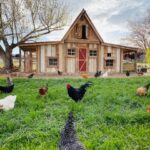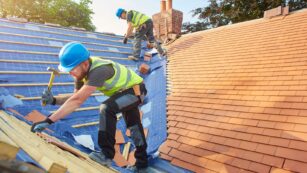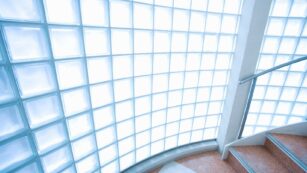This design choice is most emblematic of American barns. It works well for two-story barns that need a lot of attic space. The shape of the roof is designed in two stages. From the top, the first slope is more gradual than the second. This provides excellent drainage when snow and rain fall.
These roofs look good, but are not so easy to frame. If you are looking for plenty of storage space on the second floor, this may be the best solution for you.
Pitched roof
This double-sided roof is most common on houses and barns today. It’s called a pitched roof. It is very easy to build and provides regular snow and rain drainage. Of the four types, this is the easiest to ventilate and insulate. You can also add a second floor with this design.
The disadvantage of a gable roof is that it is more susceptible to damage from high winds. If you live in an area with strong winds, you can choose one of the other styles instead.
A single pitch roof is easier to build than a gable roof because it has only one pitch. The front of the building is higher than the back, allowing rain to run off. Keep in mind that the ground behind your shed can get very wet after a heavy rain, as the gutters lead to the back of the building, unless you install a gutter system to redistribute the water.
Generally, you will use this type of roof on a one-story building. You can also install an attic at the front of the building where the roof is higher. The disadvantage of this type of roof is that there is not much room at the back. It also collects more snow than the protruding roof because the slope is not as steep.
In a hipped roof, the four sides are the same length and meet at the top, creating a steep slope. This roofing system is generally more expensive because it requires additional materials for the frame, and is therefore less common.
On the other hand, it is a very robust construction, very suitable for drainage and resistant to strong winds. You can also add a second, narrower floor if you need more storage space.
How to choose bark roofing materials
Now that you have several barn roof models in mind, let’s see what materials you can use to finish your roof. In some ways, this is even more important than the shape of the roof itself. This protects your building from the weather and determines the level of maintenance your roof requires.
watertight
As you know, leaks are the biggest problem to fix on your roof. In addition to cracked shingles or other damage, the risk of leakage is greatest in areas along the joints and in screw or nail holes. It is therefore preferable to choose an overlapping cover material to direct water away from these vulnerable areas. You can also choose materials that are attached with glue instead of material.
Sustainability
You want your roof to last 20 years or more and require no maintenance. Metal has the longest life span. We’ll talk about metal roofs later, but the most common is corrugated steel. If you don’t like metal, the second most durable material is asphalt shingles, which most people use in their homes.
Building regulations
In rural areas, this isn’t really a problem, but check to see if your local building codes require a particular style or material for the roof. Some roofing materials may be prohibited in certain areas. It is always better to check first than to be fined or have to replace the roof when someone complains to the authorities.
Easy installation and maintenance
When you install or renovate your own shed roof, think about how easy it is to install and maintain. Asphalt shingles are the easiest to install and repair, although they require more frequent maintenance than metal. If you need to work on metal or other roofs, you will need special fasteners, while a simple roofing nail will suffice for asphalt shingles.
Flow rate
But that shouldn’t be your main concern, you want to weigh your options. What gives you the best return on investment? Will the cheapest material last nearly as long as the most expensive option? If so, it’s a better choice, even if it needs to be replaced a little sooner.
Shed roofing material variations
Given the above factors, what are the best materials to choose?
Corrugated sheet metal
The advantage of metal is that it comes in large sections, usually 8 to 10 feet long and 27 to 48 inches wide. This means fewer joints between the panels and therefore less chance of leakage. A metal roof can last 50 years or more. That means you never have to replace it.
Plus, metal roofs can even be cheaper than asphalt or cedar shingles. Of course, the price goes up if you buy the thickest and most durable caliber.
Metal roofs are usually made of aluminum or steel panels, but there are also panels made of tin, zinc or stainless steel. Aluminum is good because it’s lighter, but if there are high winds in your area, heavier steel sheets are preferable. It is interesting to note that there is not much difference in price. Rare metals are much more expensive.
If people don’t use metal, it’s because they don’t find it that attractive. This problem is somewhat downplayed at the barn, as it is more of an addiction. Metal has the advantage of reflecting heat, keeping the barn cool inside. On the other hand, it’s not as intuitive to install and can be more difficult to repair than shingles, as it usually requires replacing the entire panel rather than patching it up.
Asphalt tiles
Asphalt shingles are still the most popular for several reasons:
- Their price is reasonable.
- They are easy to install
- No special tools required for maintenance
- They should last 20 to 30 years without complete replacement.
Yes, asphalt shingles can be damaged or blown off by high winds, depending on the slope of the roof, but they can also be easily repaired.
So why wouldn’t you want to use asphalt shingles for your shed roof? Well, they’re not that visually appealing. Yes, they are functional, but they are also too normal. You do nothing to bring your design forward. Maybe it doesn’t matter to you, but some people want something fancier.
A more practical reason not to choose asphalt shingles is that they absorb and retain heat, making it warmer inside your building than it would be if it were covered with a more reflective material. You also don’t want to put asphalt shingles on a flat roof. The slope should be at least 2/12, an increase of 2 inches for every 12 inches of travel to ensure adequate drainage.
Cedar Shingles
Cedar shingles are more expensive than asphalt, but also much more fashionable. They can last as long as as asphalt, but require more regular maintenance, including painting and replacing broken shingles. Frost and ice expansion can be difficult on a cedar roof. They also soften and break in sunlight.
Since this natural material is not particularly water repellent, you should provide a steep slope (at least 4/12) so that water can drain away.
Wood shingles
Like cedar shingles, they give your roof a natural look, but because of the way they are cut, they are usually twice as expensive as shingles. The necks follow the grain of the wood, giving it an irregular but more fashionable appearance. Ironically, they are not as waterproof as cedar shingles, but they can last longer, up to 30 years, if you care for them properly.
The cocktail consists of cedar, mahogany and cypress. Each type requires a slope of at least 4/12. Like cedar shingles, wood shingles reflect heat very well.
Other roofing materials
Asphalt Feltis coated with asphalt, but is supplied in rolls. It is a very inexpensive roofing material that will keep your roof waterproof if installed properly, but it will only last about 15 years. It also absorbs heat.
EPDM rubber is another durable and inexpensive material. It can last up to 50 years, but you must be careful and repair any damage, as this roofing material digs easily.
Rubber shingles are more expensive, but you may prefer the look. They last as long as sandwiches.
Polycarbonate sheets are thick plastic sheets with a foam layer for insulation. They are medium-sized and last 10 to 20 years, although they scratch the surface quite easily.
Metal shingles are moderately priced, but still quite rare. They last a lifetime.
plank roofs wooden slatted roofs. They are easy to replace when damaged, but they are even more expensive than wood shingles and are probably prohibitive for a barn.
Ceramic tiles can last up to 75 years, but they are not particularly waterproof and can easily break on impact. They’re pretty expensive.
For more information on other roofing materials, click here.
Post Views :
5
frequently asked questions
What is the most reliable type of roof for a barn structure?
The gable roof is ideal for a two-story barn because it provides more storage space and more headroom. It has two slopes, one steeper and one lower. This type of roof, most often found on large farms and houses, provides excellent drainage.
What is a barn roof called?
A playground roof or playroom roof is usually a symmetrical two-sided roof with two pitches on each side. (A common architectural term in 18th century England and North America was Dutch Roof). The upper slope is slightly inclined and the lower slope is steep.
What are the different styles of barns?
7 classic barn-style American hobby farms
Related Tags:
Feedback,barn roof styles names,old barn roof styles,gambrel roof styles,monitor roof barn,barn roof materials,monitor roof style,monitor barn styles,gambrel roof,barn roof material,barn style roof with overhang,barn roof style house,mansard roof vs gambrel roof,gambrel roof house,gambrel roof trusses,jerkinhead roof,what is a mansard roof,a curved roof utilizes what type of trusses,different types of roofs with pictures,types of roof materials,list of roof shapes,dutch gable roof,pyramid hip roof,types of shed roofing materials,shed roof type,shed roof types uk,skillion roof pole barn,pole barn with gable roof,Privacy settings,How Search works,Mansard roof,Hip roof,Mono‑pitc… roof,Dutch gable roof,Gable roof,Flat roof,See more,mansard roof,gable roof,hip roof,types of roofs













